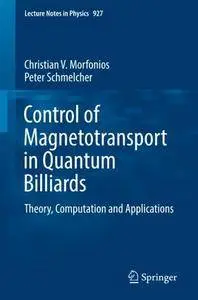Control of Magnetotransport in Quantum Billiards: Theory, Computation and Applications
Springer | Physics | December 15, 2016 | ISBN-10: 3319398318 | 252 pages | pdf | 7.93 mb
Springer | Physics | December 15, 2016 | ISBN-10: 3319398318 | 252 pages | pdf | 7.93 mb
Authors: Morfonios, Christian, Schmelcher, Peter
Gives formulas for computational quantum transport in multiterminal and multiply connected structures
Explains magnetoconductance switching in the deep quantum regime
Discusses directional transport in nanostructures
In this book the coherent quantum transport of electrons through two-dimensional mesoscopic structures is explored in dependence of the interplay between the confining geometry and the impact of applied magnetic fields, aiming at conductance controllability.
After a top-down, insightful presentation of the elements of mesoscopic devices and transport theory, a computational technique which treats multiterminal structures of arbitrary geometry and topology is developed. The method relies on the modular assembly of the electronic propagators of subsystems which are inter- or intra-connected providing large flexibility in system setups combined with high computational efficiency. Conductance control is first demonstrated for elongated quantum billiards and arrays thereof where a weak magnetic field tunes the current by phase modulation of interfering lead-coupled states geometrically separated from confined states. Soft-wall potentials are then employed for efficient and robust conductance switching by isolating energy persistent, collimated or magnetically deflected electron paths from Fano resonances. In a multiterminal configuration, the guiding and focusing property of curved boundary sections enables magnetically controlled directional transport with input electron waves flowing exclusively to selected outputs. Together with a comprehensive analysis of characteristic transport features and spatial distributions of scattering states, the results demonstrate the geometrically assisted design of magnetoconductance control elements in the linear response regime
Number of Pages
X, 252
Number of Illustrations and Tables
1 b/w illustrations, 48 illustrations in colour
Topics
Semiconductors
Optical and Electronic Materials
Nanotechnology and Microengineering
Magnetism, Magnetic Materials
Nanoscale Science and Technology
Keep Track of the latest Academic books by Clicking Here



